Call Us
+86 136 6007 9809
Call Us
+86 136 6007 9809
May. 20, 2023
A weld nut is a nut that is suitable for welding on the outside of the nut. It is an internally threaded fastener used with screws. It has a wide range of uses, high strength, high-temperature resistance, and is not easy to deform. It is often used in some products, primarily cars, and other products. A weld nut is a type of nut suitable for external welding. They are generally made of thicker, weldable materials and are ideal for welding. Welding is equivalent to turning two separate parts into a whole. Metals are melted at high temperatures, mixed, and cooled. The metal is added in the middle, and the internal force is the molecule. The strength is generally more significant than that of the parent body. Testing of welding parameters depends on the fusion size of the weld. Adjust the welding parameters to the fusion size until the defect is eliminated. Of course, the welding quality and welding manufacturing process is the process of applying heat or pressure to the material of the workpiece (same or different) or both, with or without filler material, so that the materials of the workpiece are established between atoms and form a permanent connection. A weld nut is an internally threaded fastener with a bolt to transmit motion or power. Its features are relatively high strength, wide application range, and thinness and thickness. However, the connection parts will be deformed due to the high temperature and cannot be disassembled. Some active metals, such as aluminum, magnesium, etc., cannot be welded by the usual methods and need to be fused with shielding gas or argon arc welding, which requires processing technology and precision.
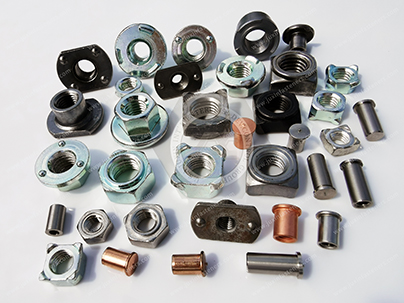 | 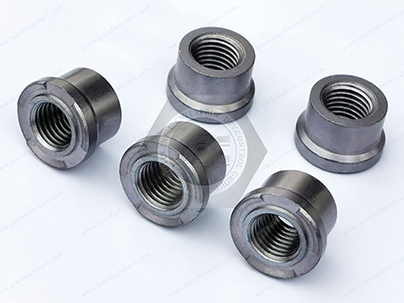 |
Which industries are weld nuts mainly used in?
Although the weld nut has high strength and is not easy to loosen, there are still some precautions to take so that the weld nut can be used. Weld nuts have a small scope of application and are only used in the sheet metal industry and chassis factories. Weld nuts are divided into hexagonal and square weld nuts according to shape. The materials are carbon steel and stainless steel and are generally used as internal sheet metal threads. The weld nut is welded to the metal plate by spot welding technology and fixed to form a compelling internal thread. The welding nut has positioning feet for easy welding. Surface treatment is generally not performed to maintain the weldability of the nut. The production process of weld nuts is cold heading. The use of welding nuts is the same as that of riveting nuts, which are used as internal threads of sheet metal. However, the principles of the two are pretty different. Rivet nuts are held in place by tooth embossing at the head and snap-in at the sheet metal base. The precision and riveting strength of the rivet nut may cause the rivet nut to loosen, while the welding nut is welded by spot welding technology. Although the installation is troublesome, the welded nuts are firm and do not easily fall off. Although the weld nut has high strength and is not easy to loosen, some precautions remain to take to connect and use the weld nut. The so-called welding is to turn two separate parts into a whole. The metal is melted and mixed at high temperatures, then cooled, and the alloy is added in the middle. The molecular force inside is slightly larger than that of the general matrix. Therefore, weld nuts are widely used.
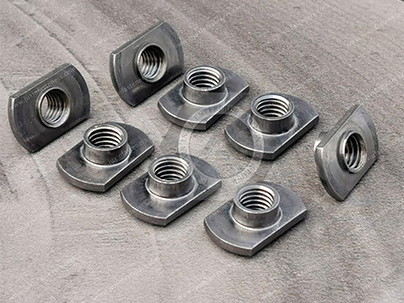 | 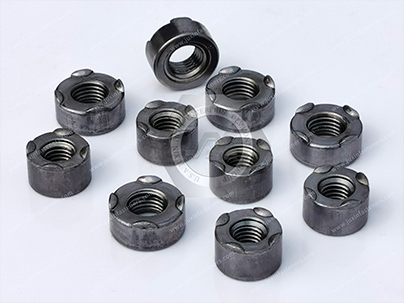 |
What should I pay attention to when welding nuts?
、When welding, keep the whole working environment ventilated; otherwise, the air is not circulated, and the room will produce harmful substances, affecting people's health. And when welding, you must use blocking net protection to prevent danger.
2. During the welding process, pay attention to the welding part and tungsten pole centerline angle, maintaining between 80 ° and 85 ° to better protect the welding pool.
3, and the filler wire and welding surface angle are to be within 10 ° to ensure the entire nut surface is fully welded to prevent the nut accessories from being lost.
Four 、When welding the nut, several chamfers are on it, so during the welding construction, the current will be concentrated at these chamfers to form a solid weld joint. Therefore, the welding should change the angle appropriately to prevent too much current from damaging the chamfer.
Five 、If you are welding ordinary nuts, the welding current requirement is more significant and longer to provide sufficient heat for the molten nucleus to form a stable and solid welded joint. When welding nuts, you need to master professional skills to complete the welding of nuts and pay attention to safety to prevent the occurrence of danger. We will continuously adapt to meet evolving customer requirements. We are uniquely equipped to provide the total assembly solution! If you are looking for high-quality fasteners or technical support for structural.
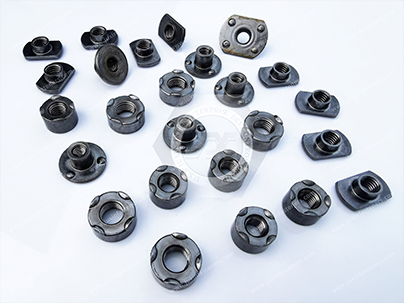 | 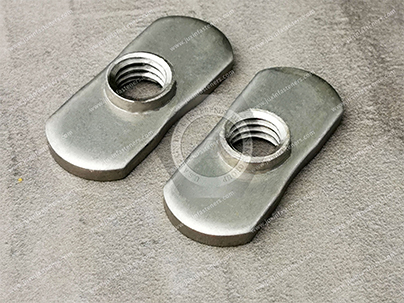 |
Specifications for sheet metal welding
(1) Requirements before welding of sheet metal parts
1. All raw materials must not be lower than the requirements of the drawing. Otherwise, no blanking will be allowed.
2. It is required that the flatness of welded steel should not exceed 2/1000, and the total bending degree should not exceed 0.3% of the entire length.
3. Before welding sheet metal parts, deformed parts must be straightened and leveled before welding.
4. Before welding, welding wires with different thickness specifications should be selected according to the parts' size, the material's thickness, and the weld's required size.
(2) Requirements for the welding process
1. The welding is made according to the drawings, technology, and process requirements. If there is an error in the drawings, which leads to the wrong welding of the workpiece and needs to be re-welded, the part will be treated as a defective product.
2. When welding, the place where the groove is required must be grooved. If the workpiece has no groove or welding profiles, etc., the groove should be made with a grinder according to the situation. If the groove needs to be machined, the groove should be processed. , and escalate the problem to the department head.
3. The shape and position tolerance of the workpiece should be guaranteed during welding, and the shape and position tolerance of the non-processed surface should be implemented according to the IT15 level.
4. If a substitute material is required during welding, the thickness of the sheet material does not meet the drawing's requirements, and the substitute material cannot be used without the technical department's written consent.
5. The weld seam during welding is strictly to the requirements of the drawings. If the continuous welding is continuous welding, the intermittent welding must be intermittent welding. If there is no required periodic welding size and length in the drawing, then 8 to 10mm should be welded at intervals of 50mm, and the distance between each solder joint must be uniform.
6. The continuous weld seam must be straight and smooth, without apparent unevenness, welding penetration, welding deviation, welding scar, air hole, undercut, etc. The fillet of the weld is subject to the requirements of the drawing, and the minimum thickness of the adjacent piece is guaranteed if there is no requirement.
7. After the welding is completed: each weld seam should be polished to remove welding slag and remove peripheral burrs.
8. The parts that require bending on the drawings shall not be welded without the written consent of the technical department.
9. During the welding process of sheet metal parts, the part that needs to be knocked can be lightly hammered to the required size with a small manual hammer, and it is not allowed to hit with a hammer on the sheet metal plane.
(3) Requirements and standards for post-weld treatment
1. The weld seam is smooth, with fish scales; there must be no piled-up convex hulls and uneven phenomena.
2. After the workpiece is welded, the appearance should be re-polished with emery cloth, and there should be no thorns and corners; there must be no welding slag, solder joints, burrs, etc., and the weld seam should be smooth and flat. The "edges and surfaces" should be guaranteed, including the vertical parallelism of the opening edge of the workpiece.
3. The welding seam on the plane of the box-type workpiece should not be higher than the plane. In principle, it should be able to cover it after the putty is applied, and the welding seam should not be seen.
4. The revolving parts, especially the planes that will not be processed after welding, must be strictly protected during welding to avoid arc damage or welding slag damage, and the premise that the weld seam is uniform cannot be ground casually.
5. Sandblasting is performed uniformly for the sheet metal parts that must be blued and electroplated after welding after the welding is completed and the relevant requirements are met. During the turnover process, strict protection should be taken to avoid bumps and scratches, and no further grinding should be performed.
Fastener solutions for the sheet metal industry:
Pressure riveted parts are mainly used for thin plate connecting elements, which can occupy a small amount of fixed space and achieve the role of fastening products. In some communication cabinets and new energy vehicles, PACK box structure can often be seen; pressure riveted fasteners are a form of fasteners with pressure riveting structure; pressure riveted parts generally have several categories such as pressure riveted screws, pressure riveted nuts, pressure riveted pins; materials are carbon steel, stainless steel, copper raw materials because it needs to use pressure riveting reasons, so the choice of raw materials need to have a higher than the installation parts 1.5 times The hardness of the material selected needs to be about 1.5 times higher than the installed part to make it properly installed on the product part. The rivet nut is pressed into the hole of the sheet by a certain pressure, which causes plastic deformation around the hole and squeezes into the guide groove, thus producing a locking effect. The demand for sheet metal fasteners will continue to grow as technology and the economy develop in all areas. The design of sheet metal has become an essential part of the product development process, so mechanical engineers must master sheet metal design skills so that the designed sheet metal not only meets the functional and cosmetic requirements of the product but also makes the manufacturing of stamping dies easier and less costly. Fasteners have also become a necessary part of the designer's consideration. The press rivet nut made of carbon steel is indicated by JX-S, which is suitable for riveting aluminum and steel plates with plate hardness HRB≤80. press rivet nut can be divided into carbon steel press rivet nut JX-S, stainless steel press rivet nut JX-CLS, and stainless steel press rivet nut JX-SP according to the material. Ju Xin is used in rail transportation, new energy automobile, machinery manufacturing, electronic communication, the construction industry, the photovoltaic industry, the Automation industry, pump valve/water treatment, aerospace, and many other industrial applications to provide the corresponding fastener industry solutions, in all walks of life have a team of experienced and professional engineers to offer end industrial customers with customized services for each industry module, to provide fastener management solutions for end industrial customers. We will continuously adapt to meet evolving customer requirements. We are uniquely equipped to provide the total assembly solution! Please contact me if you are looking for high-quality fasteners or technical support for structural design. Thanks.Email:sales@jxfastener.cn,
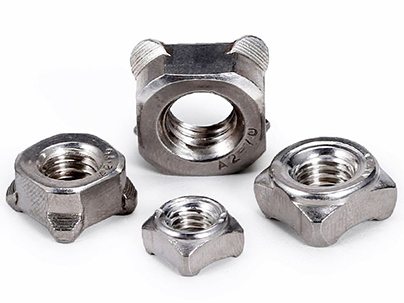 | 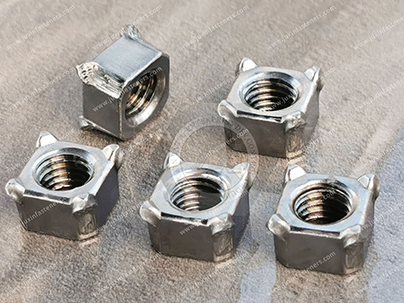 |
Did you design the weld nut correctly?
Weld nuts are relatively seldom used in other industries, and other sectors can use pretty thick steel plate designs, which can be directly processed into the form of internally threaded holes. It is precise because weld nuts are widely used in the automotive industry, and the definition of this weld nut is not perfect in the industry standards. We design, and there are various problems during on-site assembly, especially the frequent occurrence of thread slippage—reasonable application of weld nut selection to avoid design problems. The primary standards of welding nuts are: welding square nuts, welding hexagonal nuts, welding nuts for automobile seat belts, welding round nuts, welding hexagonal flange lock nuts, welding hexagonal flange nuts (welding flange surface nuts), T-welding Nut, and other standards, standard number: Q371B, Q370D, Q369, Q368, Q366, Q364, JISB1196, etc.
1. When designing, paying attention to some weld nuts' standard proof load requirements is necessary, consistent with the proof load GB/T3098.2 legal requirements of corresponding grade nuts. The requirements for weld nuts in the standard are between the normal nut-proof loads for class 6 and class 8 nuts. The standard's proof load requirements of welded nuts are prone to problems when matching with 8.8-grade bolts, let alone matching with 10.9-grade bolts. This design was barely acceptable in the era when the torque method was mainly used. Still, now, more and more in the automotive industry, the torque-torque-angle method is used to tighten the torque above the yield so that even if the bolts that match the 8.8 grade are used, It will happen that the axial force of the bolt reaches the minimum breaking load, so there will be a situation where the welding nut slips when tightened.
2. There is another situation that needs to be paid attention to. Welding nuts are currently produced by cold heading. Generally, cold heading causes cold deformation and strengthening. However, after welding, the welding heat input will often reduce the strength of the welding nut to a certain extent. Thus, the strength of the weld nut after welding is diminished, and the proof load will be reduced. The proof load after welding will have difficulty meeting the required proof load requirements.
3. Due to the larger contact surface of the flange surface welding nut, there will be no crushing behavior when the torque angle method is tightened or when the material strength of the connected parts is relatively low; the flange surface welding nut can be preferably selected. The welding square nut has four convex welding points, while the flange surface welding nut has three convex welding points, so the three points form a plane, and it is easier to ensure the parallelism requirements after welding during welding. If you change from welded square nuts to flanged welded nuts, you need to pay attention to the change in the length of the bolts.
4. The design principle of the matching of bolts and nuts is that the strength of the nuts must at least match the performance level of the bolts of the same level. Higher-level nuts can be required to fit low-level bolts to ensure the teeth will not slip during assembly. For example, for grade 8 nuts, the highest grade of bolts that can be matched is grade 8.8. In addition, for designs such as all-metal lock nuts, bolts of the same grade are generally required to fit, and it is not recommended to adopt a design with lower grade requirements. For example, grade 10 all-metal lock nuts should not be used with grade 8.8 bolts.
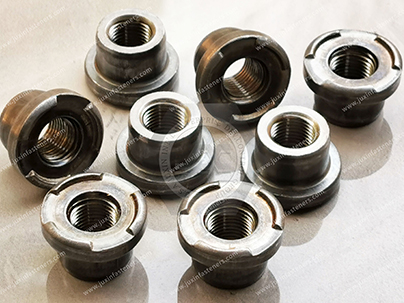 | 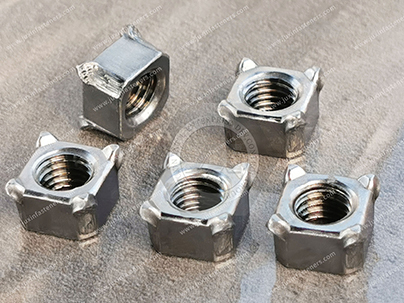 |
Precautions for high-strength bolts
Quality precautions
(1) Surface floating rust, oil, bolt hole wall with burrs, weld tumors, etc., should be cleaned up.
(2) After treatment, The contact friction surface should reach the required anti-scratch coefficient. High-strength bolts should have matching nuts and washers when used by the matching use; they are not interchangeable.
(3) When installed, the friction surface of the treated components is not allowed to absorb oil, dirt, and other debris.
(4) The friction surface of the components should be kept dry during installation and not be operated in the rain.
(5) Strictly check and correct the deformation of the connected steel plates before installation.
(6) Hammering into the bolt is prohibited during installation to prevent damage to the bolt fillet.
(7) Regularly test the electric wrench to ensure the torque's accuracy and operate in the correct torsion order.
Main safety technical measures
(1) The active wrench size should match the nut size, and no casing should be added to the slight twist. The high-altitude operation should use dead wrenches, such as live wrenches with a rope tethered, and people should be tied with safety belts.
(2) when assembling the steel connecting bolts, it is strictly forbidden to insert the connecting surface or probe the screw holes by hand, and when taking and placing the gasket plate, the fingers should be placed on both sides of the gasket plate.
Advantages of the use of self-clinching nut fasteners in the automotive chassis and industrial sheet metal cabinet industry
1. the back of the plate remains completely flat.
2. small and compact, suitable for all electronic communications, base station equipment, medical, industrial precision, catering equipment, new energy vehicle PACK, and other equipment.
3. high torsional resistance.
4. Convenient equipment, requiring only simple riveting.
5. Serialized specifications can meet various mechanical connection structure design requirements.
The installation of self-clinching riveted fasteners should be precisely controlled according to the size of the hole, preferably punched. Riveled nuts should generally be installed from the "off" side of the plate. The installation process is usually achieved through the "riveting" operation, never impacting knock-in.
1. For installation of self-clinching rivet series fasteners, we must ensure that we install the aluminum plate anode after the surface treatment or oxidation operation.
2. Before installation, we must find the proper installation force; if the force is too large, the head of the rivet nut fastener will be flattened, and even the threads will be twisted and deformed.
3. You cannot install self-clinching nuts and other stainless steel riveted fasteners with a hammer. The installation process is generally achieved through the "riveting" operation, never impacting knock-in.
4. To make the stainless steel self-clinching nuts fasteners, such as force point to the plate, install screws from the opposite side of the head of the riveted fasteners.
5. When installing fasteners on plates, ensure the surface does not need to be pre-painted.
The use of riveting studs, installation met, hods, and principles have been determined. However, the riveting studs still need special equipment to operate, which also ensures that the riveting studs, after the completion of the installation, maintain stable performance indispensable factors. The installation should keep the riveting machine and the head of the riveting stud vertically balanced and evenly pressed.
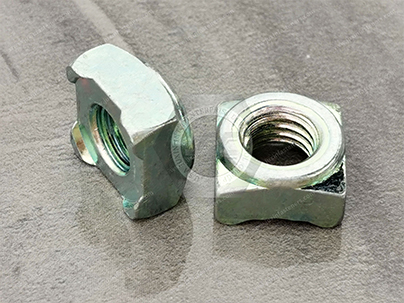 | 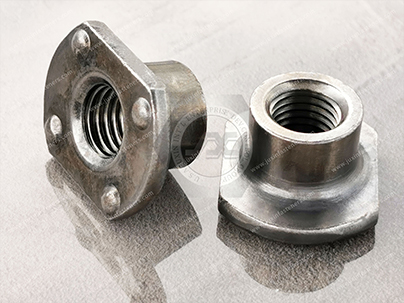 |
The basic concept of screw production:
1. The manufacturing method of screws can be divided into cold heading, hot beating, and machining (turning, milling, etc.). (Now mainly introduce cold heading, hot beating, and turning as knowledge)
2, The definition of cold heading: The use of metal plasticity, the use of complex mechanics to apply pressure or cold drawing, to achieve the purpose of solid metal deformation. The forging and forming method thickens the top of the bar or wire at room temperature.
3. The application range of cold headings is mainly used to manufacture bolts, nuts, nails, rivets, steel balls, and other parts. Forging billet materials can be copper, aluminum, carbon steel, alloy steel, stainless steel, and titanium alloy.
4. The excellence of cold heading: material utilization rate can reach 80-90%, high production efficiency, up to 300 pieces/min or more.
5. Definition of hot upsetting: hot upsetting is heating the material after pressure processing to make the shape of the material meet the design requirements. The material is heated and put into a particular form of the mold forging molding way, also known as thermal processing, also called a red hit; this is a large bolt only with a red hit.
Nylon locking nut principle
1、The working principle of nylon lock nut is to use the friction between the nut and the bolt to achieve self-locking. However, under dynamic load, the reliability of this self-locking will be reduced. For certain important occasions, we will take some anti-loosening measures to ensure the stability of the nut locking.
2, locking nuts is one of the anti-loosening measures. The locking nut's anti-loosening effect depends mainly on its force of interaction with the nut-engaging threads. Various methods can improve the force between the engaging threads, such as improving the thread structure of the sizing nut, nylon nut nylon increases brownness, thread surface treatment, etc., and improve the interaction force between the engaging threads. The nylon lock nut is a round nut with four minor grooves all around, fixed on the stud body with a multi-month wrench; the lock nut fits well with the shaft pad, and the little groove on the stud is set with the outer central groove to prevent loosening. Currently, there are many new and different designs of lock nuts. Still, all are to avoid loosening, the nut from the outer surface to the inner threaded surface of the threaded hole (usually 2, the distribution of 90 on the outer surface), tighten the small diameter countersunk screw so that the screw to the center of the pressure to prevent the lock nut loose.
3, when the nut is installed on the nut, the nut is embedded in the nylon nut thread extrusion so that the nylon will be deformed to install the nylon and thread, and the extruded nylon will give the bolt an excellent elasticity, thus increasing the friction, so that the bolt is not easy to loosen.
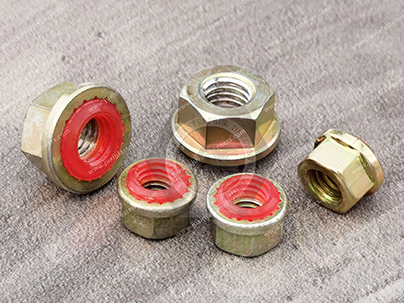 | 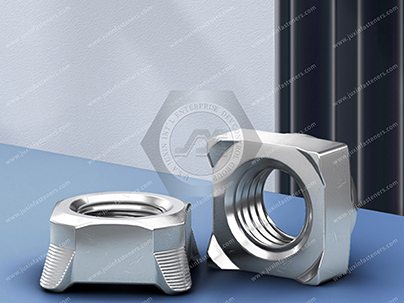 |
Contact Us
Tel.:
+86 020 8621 0320
+86 020 3121 6067
Technical Support:
Navigation
SEND INQUIREY